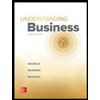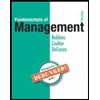
To Determine
Two kinds of important areas to be determined by managers to implement an organization’s strategy are to be spelled out here in this solution.
Introduction:
Today any organization implements various strategies to sustain its growth trajectory, stand out in cut throat competition, and meet its various business objectives. In this question, we will identify two important areas to be determined by managers to implement set out strategy.
Answer to Problem 1UTC
Solution:
Organization’s strategy is defined as the total sum of the actions a company takes in order to attain its long term objectives. Strategies take long periodfor implementation and needs involvement and active participation from all employees and stakeholders.Organizational strategy arises from a company's mission to be in business. From the vision follows the long-term goals of an organizational strategy.
Methodology usage is characterized as "the making an interpretation of a picked procedure into authoritative activity in order to accomplish key objectives and targets". It is the outline to be sought after as respects the manner in which an association ought to create, use, and amalgamate authoritative structure, control frameworks, and culture to seek after systems that prompt upper hand, spectacular execution and better business development. An all around planned system will fizzle in the event that it isn't appropriately actualized. In this way Every chief must decide very much explained, well thoroughly considered, and all around created zones of activity to actualize the association procedure in letter and soul.
Explanation of Solution
Managers’ focus areas to determine for proper implementation of strategy-
- Proper alignment among different verticals in an organization to support business strategy-
- Handle change management, Drive innovation for speedy transformation and successful implementation-
A manager should create proper work environment, encourage employees to constantly improvise, and develop a congenial workplace atmosphere. He should align the relationships between an organization’s core business units, and shared services in tune with organizational strategy. Managers need todrivethe need for constant alignment between organization and individual goals across the company. For a successful strategy implementation, managers should create a right organizational structure encompassing information overflow, decision making processes, and job assignments and make the employees understand to put their best to take the organization to next level of business growth trajectory to meet emerging competition in a digital world in line with the new strategic direction set by the top management. They should properly clarify and communicate the Board set strategies to remove any irritants cropping up during implementation phase. No policy or direction should be stated vaguely so as to avoid subsequent confusion and blame work if the organization fails to get the strategy implemented in right manner and within stipulated timelines. If the team meetings, the personal interactions, the process improvements, communications, the customer meetings, mission and vision statements, and market penetration strategies are in alignment with an organization’s strategy, a manager can make a tremendous difference for an organization.
Managers with effective communication and change management practices are eleven times more likely to listen carefully to divergent points of view during implementation of the strategy. Managers must emphasize driving among employee’s better product and service quality. Managers need to create a structure that recognize various group leaders, the duties of those group leaders and a system of accountability that insures that the implementation team meets its timelines for getting the new program or policy in place.
Implementation strategy is the pivotal role for the manager. He should take ownership that despite all roadblocks, they would ensure that strategy is implemented on time and desired result is brought about with cohesion among all units of an organization synchronizing. Now in digital age, innovation is essential to be in marketplace. Managers should drive home the percept of ‘survival of fittest’ in today’s environment and drive their transformational areas accordingly.
In a nutshell, we can zero in on the conclusion that managers play the most vital role for proper strategy implementation. If they work in a razor-sharp focus, with an eye on details, promote out of box thinking, appreciate top performers, drive and motivate teams at lightning speed accurately as per management’s plans, goals and vision, they can definitely be successful. Through above important areas managers can promptly any organizational strategy anywhere in the world irrespective of organization size, difficulties, other challenges, and emerge champions and successful strategic leaders.
Want to see more full solutions like this?
Chapter 8 Solutions
Loose-Leaf Edition for Management
- Management of diversity is important to a company's workers because: Question 14Answer a. Employees mainly learn about the differences among themselves b. Employees learn about the drawbacks of diversity c. Employees learn about the wealth that it brings to their company d. Employees learn about the class differences among themselvesarrow_forwardIdentify, in the correct order, the key steps which must be followed when developing a global strategy: a.Decide whether to globalize, where to globalize, how to globalize b. Decide whether to globalize, where to globalize, internationalize the core strategy c.Develop the core strategy, internationalize the core strategy, globalize the core strategy d.Develop the core strategy, locally market the core strategy, internalize the core strategyarrow_forwardThis structure is created around cross-functional core processes, with self-managed work teams, providing teams with the ability to think outside the box, and people being empowered with the necessary skills, tools and authority to make vital decisions a.Matrix structure b.Divisional structure c.Horizontal structure d.Functional structurearrow_forward
- _________________ are defined as forces that shape on organisation’s strategy a.Strategic Drivers b.Human Resources c.Strategic Leversarrow_forwardA clearly defined __________________ directly addresses the question “What is our business?” from an organisational standpoint and distinguishes it from another similar firm a.Vision statement b.Business plan c.Strategic Plan d.Mission Statementarrow_forward___________________refers to the process of redesigning a vertical organisation along its horizontal workflows and processes. Rather than focusing on narrow jobs structured into distinct functional departments, they emphasise core processes that cut horizontally across the organisation and involve teams of employees working together to serve customers a. Business Process Reengineering b. Horizontal Configuration c. Structural Reengineering d. Workforce Configurationarrow_forward
- ___________________refers to the process of redesigning a vertical organisation along its horizontal workflows and processes. Rather than focusing on narrow jobs structured into distinct functional departments, they emphasise core processes that cut horizontally across the organisation and involve teams of employees working together to serve customersarrow_forwardAssuring results is an attainable habit of a strategic leader only if a strategic leader is intentional in developing high performing organisations. Strategic leaders must be intentional in this because they can shape the organisational culture, or the culture may ‘manage’ the leader. One way to do this is to ______________ a.Develop a Strategic Leadership plan b.Develop a Vision Statement c.Implore levers of change d.Develop a Strategic Implementation Planarrow_forwardSupporting Strategic Initiative Through HRM Policies Given the strategic initiative and organization described in your Module 2 and Module 3 Critical Thinking assignment submissions, discuss the Human Resources Management (HRM) policies that would consistently and coherently support attainment of your strategic initiative. These policies might address recruitment, selection, training/development, performance evaluation, compensation, and dismissal. Briefly describe the organization and your initiative. Describe HRM policies you think are important to implement your strategic initiative. Describe rewards and incentives that would be used to ensure compliance, buy-in, and effort to make the strategic initiative successful.arrow_forward
 Understanding BusinessManagementISBN:9781259929434Author:William NickelsPublisher:McGraw-Hill Education
Understanding BusinessManagementISBN:9781259929434Author:William NickelsPublisher:McGraw-Hill Education Management (14th Edition)ManagementISBN:9780134527604Author:Stephen P. Robbins, Mary A. CoulterPublisher:PEARSON
Management (14th Edition)ManagementISBN:9780134527604Author:Stephen P. Robbins, Mary A. CoulterPublisher:PEARSON Spreadsheet Modeling & Decision Analysis: A Pract...ManagementISBN:9781305947412Author:Cliff RagsdalePublisher:Cengage Learning
Spreadsheet Modeling & Decision Analysis: A Pract...ManagementISBN:9781305947412Author:Cliff RagsdalePublisher:Cengage Learning Management Information Systems: Managing The Digi...ManagementISBN:9780135191798Author:Kenneth C. Laudon, Jane P. LaudonPublisher:PEARSON
Management Information Systems: Managing The Digi...ManagementISBN:9780135191798Author:Kenneth C. Laudon, Jane P. LaudonPublisher:PEARSON Business Essentials (12th Edition) (What's New in...ManagementISBN:9780134728391Author:Ronald J. Ebert, Ricky W. GriffinPublisher:PEARSON
Business Essentials (12th Edition) (What's New in...ManagementISBN:9780134728391Author:Ronald J. Ebert, Ricky W. GriffinPublisher:PEARSON Fundamentals of Management (10th Edition)ManagementISBN:9780134237473Author:Stephen P. Robbins, Mary A. Coulter, David A. De CenzoPublisher:PEARSON
Fundamentals of Management (10th Edition)ManagementISBN:9780134237473Author:Stephen P. Robbins, Mary A. Coulter, David A. De CenzoPublisher:PEARSON





